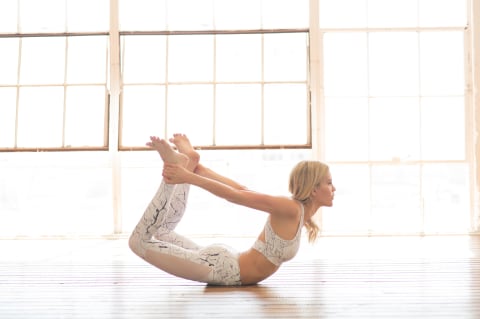Advertisement

When people hear about the backbends of yoga they often envision a contortionist with their head resting on their buttocks. Bending backward looks pretty tough; even a bit painful. A few years ago a student expressed feeling pain just by looking at the backbends on the wall at my yoga school in Toronto.
“Hm, I thought, they look good to me!”
But if the truth were told even for practitioners like me who have been practicing backbends for years know it is not easy. For anyone interested in the practice here’s how to take backbends in your yoga stride.
Here are the seven things you need to know:
1. Backbends shake you out of your comfort zone.
If we stop and think about it most (if not all) of our daily movements are limited to moving forward. Rarely do we spend time defying gravity by moving upside-down, backward or sideways. It just feels natural to bend forward. It’s also the obvious thing to do when picking something off the floor. However, backbends offer an exciting way to move the spine. This creates better balance between our normal activities and breaks-up the rigidity of the spine.
2. Keep your brain healthy and your heart active.
Medical studies have shown many people suffer from chronic back-pain. An interesting study conducted in an American university linked the effects of continuous low back pain to lowering the grey matter of the brain. (Read Losing Your Mind From Back Pain.)
Yoga Master B.K.S. Iyengar recommended backbending as a cure for depression. He further advised that backbends be used as a holistic alternative for heart patients. Because backbends stretch the heart they relieve tensions stored in the muscles and help send off natural pain-killers. They may also cure depression and boost the immune system.
3. Backbends are a great teacher of life skills.
When we come face-to-face against our physical edge our minds our challenged. This presses us to develop patience or to drop-out. If we to stick to the task we will benefit from the practice in learning how to slow down as well as breathe. The practice also takes energy, devotion, will, discipline and care; all good things for life. And being true to life, backbending is no exception in that there are set-backs. Sometimes we stretch too much and need to learn our limits.
4. There is no traditional system of Hatha-yoga that omits backbends.
To name just a few of the traditional forms Sivananda-yoga contains wheel (chakrasana), bridge (setu-bandha sarvangasana) and locust (shalabhasana) as its basic postures. In the primary series of Ashtanga-yoga the pickings are slimmer, but wheel still shows up. In AtmaVikasa Yoga developed by Yogacharya V. Venkatesha, a full system of backbends is taught. These range from the crocodile posture (makarasana) to full locust (shalabhasana) to camel (ushtrasana), with a closing sequence offering bridge and wheel.
5. Backbending yoga is a not just a class of non-stop backbends.
In the charming city called Mysore (perhaps more famous for being the home to the late Shri K. Pattabhi Jois), Yogacharya Venkatesh has been teaching for over 20 years special backbending classes to a handful of students at a time. His classes are not for the elite, but a wide range of older, stiffer bodies to younger and bendier ones. These classes are structured to suit individual need. As well, they are not just a class in non-stop backbends. Forward bends and other counter postures are given a lot of emphasize by holding them for double the time as the backbends. FYI: If you decide to go to Mysore you can only study under one teacher at a time (no cheating).
6. Backbends are uncomfortable but far more than contortions.
It is a misconception to think the practice is only about contortionism. It does contain some pretty extreme and unusual positions, but that’s not the whole picture. Frankly speaking, what can you honestly expect if you have never bent backward before? Notwithstanding medical issues or injuries backbends extend the entire spine and move the body laterally, forward and backward.
7. The practice never promised Cirque du Soleil.
In the end, the bud of yoga appears differently from one practitioner to the next. In other words, getting your feet to your head may or may not be the goal. Does that make you are less interested and/or insincere in your practice? No matter how the flower of the practice appears it is the promise of Patajalim's Yoga for growth. Of course, Patajalim never promised it would be easy. But we are guaranteed success with a consistent practice and a sincere effort.
Sound pretty good to you? If you're inspired to take your backbending further, I hope you can check out my YouTube channel :)
Happy backbending!
Watch Next
Enjoy some of our favorite clips from classes
Enjoy some of our favorite clips from classes
What Is Meditation?
Mindfulness/Spirituality | Light Watkins
Box Breathing
Mindfulness/Spirituality | Gwen Dittmar
What Breathwork Can Address
Mindfulness/Spirituality | Gwen Dittmar
The 8 Limbs of Yoga - What is Asana?
Yoga | Caley Alyssa
Two Standing Postures to Open Up Tight Hips
Yoga | Caley Alyssa
How Plants Can Optimize Athletic Performance
Nutrition | Rich Roll
What to Eat Before a Workout
Nutrition | Rich Roll
How Ayurveda Helps Us Navigate Modern Life
Nutrition | Sahara Rose
Messages About Love & Relationships
Love & Relationships | Esther Perel
Love Languages
Love & Relationships | Esther Perel












